Yesterday was overcast and the high temperature only reached 33 degrees, but somehow it didn’t feel as cold as it had the few days before. I spent a solid hour and a half out back harvesting greens and playing with the chickens who ventured into the yard for the first time in days. The weather is supposed to get nasty again the next few days and through the weekend, so I pulled up my snowpants and made the best of it.
Here are a few scenes from the field.

A solid blanket of snow covered everything and made accessing the tunnels a chore. I did a little maintenance, but have more to do to support the ends of our low tunnels when this melts…

While the world outside the tunnels was white, a bounty of greens lay beneath. This short tunnel (covered in Agribon and plastic) contains tatsoi, pac choi cilantro, romaine, and arugula. I’ve noticed growth increasing already since the winter solstice. I harvested most of the lettuces and left a little to see how they would hold up to the sub-zero temperatures coming early next week. I wondered if plants packed closer together would fair better than those hanging out alone, which I’m noting here to remind myself to check.

A bowl of arugula, some of which was buried under the row covers, which collapsed on the ends, from the weight of the snow.

Swiss chard, tatsoi, and pac choi under a low tunnel.

Same low tunnel – Lacinato and Red Russian kale in front, spinach in the back.

Close-up of arugula in a second short tunnel.

The high tunnel continues to enchant us. The pac choi on the left was hit hard by cold two nights before but completely bounced back (see below). I plan to add some low covers inside the tunnel in advance of the super cold temperatures coming next week.


Did you know cilantro embraces the cold?

Spinach starts in a cold frame, inside the tunnel. Surprising to me (but perhaps not to someone with more scientific understanding), these frames are not holding temperature as well as the tunnel itself (see chart below). These will be transplanted into a bed the next warm spell we see. (Note: This experiment was introduced in an earlier post, referencing the MidOhio Food Bank that made it possible.)

In the basket, chard, kale, and mustard for our harvest. On the ground, the chickens’ fodder.

After school, Cora helped me document temperatures in various locations.


And the hens came out to play.





















































